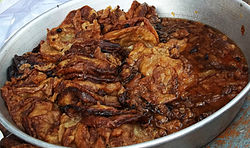- Malapua (dessert)
-
Malapua
মালপোয়া, ଅମାଲୁ
Amalu (Oriya: ଅମାଲୁ)Origin Alternative name(s) Amalu (Oriya: ଅମାଲୁ) Place of origin India Region or state Orissa, Bengal, Bihar, Maharashtra Dish details Course served Dessert Main ingredient(s) Plain flour, rice flour, sugar, coconut Malapua (Bengali: মালপোয়া, Oriya: ମାଲପୁଆ) or amalu (Oriya: ଅମାଲୁ) is an Indian pancake served as a dessert or a snack. It's an Oriya dessert [1] which is also served to Jagannath in his Sakala Dhupa (Morning food served to the lord). It is During Paush Sankranti, Malapuas are prepared in Bengali homes.Malapuas along with mutton curry is served in many non-vegetarian Maithil homes during Holi.[2]
Contents
Malapua and its varieties
The batter for malapua in some areas is prepared by crushing ripe bananas or (in Bangladesh) coconut, adding flour, and water or milk. The mixture is sometimes delicately seasoned with cardamoms. It is deep fried in oil, and served hot. The Bihari version of this dish has sugar added to the batter prior to frying, while the method prevalent in Orissa has the fritters dipped in syrup after they are fried. What is called "malpoa" in West Bengal can be a type of halwa in Bangladesh.
Malapua is popular in Bangladesh, Orissa, West Bengal, Bihar and Maharashtra where it is served during festivals along with other sweets. Amalu (Malapua) is one of the Chapana Bhoga of Lord Jagannath and included in the Sanja Dhupa (evening dhupa).[3] Other variations of Malapua use pineapples or mangoes instead of bananas. Bengali, Maithili and Oriya malapua is traditionally made only with thickened milk and a little flour (sometimes rice flour instead of wheat flour).
Malapua in northern India, particularly in Uttar Pradesh and Rajasthan, don't contain fruit. There are several variations, using some or all of the following ingredients: maida (refined flour), semolina, milk, and yogurt. The batter is left to stand for a few hours before being spooned into a kadhai of hot oil to form a bubbling pancake which should be crisp around the edges. The pancakes are then immersed in a thick sugar syrup. Malapua is a popular sweet to make on the Hindu religious occasion of Holi. Malapua is served by a jagannath tempel in ahmedabad daily as prasaad.
Bengali malapua recipe
This variety is a recepe of fried malapua. There are also versions in which it is dipped or drenched in sugar solution then served.
Ingredients:
- 2.5 cups plain flour
- 0.5 cup rice flour
- 2.0 cups sugar
- 3.0 cups water
- 1.0 cup shredded coconut
Preparation:
Mix the ingredients to make a moderately thick batter. Sugar can be added if more sweetness is desired. If making a larger quantity always have five times as much plain flour as rice flour to keep the batter together. Pour a quarter cup of batter and pour into a pan with oil. Several pancakes may be cooked at any given time, but each piece must be submerged under the oil in order to cook properly. Cook for about ten minutes and then let it cool for two minutes for an ideal flavor.
- II
- (makes 50)
Ingredients :
- 500 ml ghee
- Cardamom 50 g
- Fennel seed 20 g
- Semolina 500 g
Preparation :
Heat ghee in a deep kadhai (wok). Mix semolina with water to make a thick batter. Mix cardamom, fennel seeds and 10 g of sugar. Fry the batter in hot ghee and dip in sugar syrup.
Oriya malapua recipe
Amalu is a generic term used for the Sanja dhupa of Jagannath temple and several types of Amalu (Bada Amalu, Sana Amalu) are offered to the lords as the Sanja Dhupa(evening dhupa).
Ingredients: For Amalu
- 250 ml of Yoghurt
- 3 tbsp of refined Flour
- 3-4 tbsp of Ghee/oil for frying
- 1 tsp of Roasted fennel seeds
For Sugar Syrup (Sira/Raseni)
- 200 gm of Sugar
- Rind of 1 sweet lime
- 200 ml of Water
Preparation: Combine yoghurt, flour and fennel seeds. Stir until a smooth batter is formed. Heat ghee/oil in a pan and make dumplings by frying a spoonful of the batter at a time over a gentle flame. Remove from the pan and drain. Prepare the syrup with sugar, water and rind. Dip the Malapuas into the syrup. At home it can be garnished with sweet lime segments and cream. It can be decorated with silver leaf. It is served hot/cold. [4][5]
References
Categories:- Oriya cuisine
- Uttar Pradeshi cuisine
- Bengali cuisine
Wikimedia Foundation. 2010.

